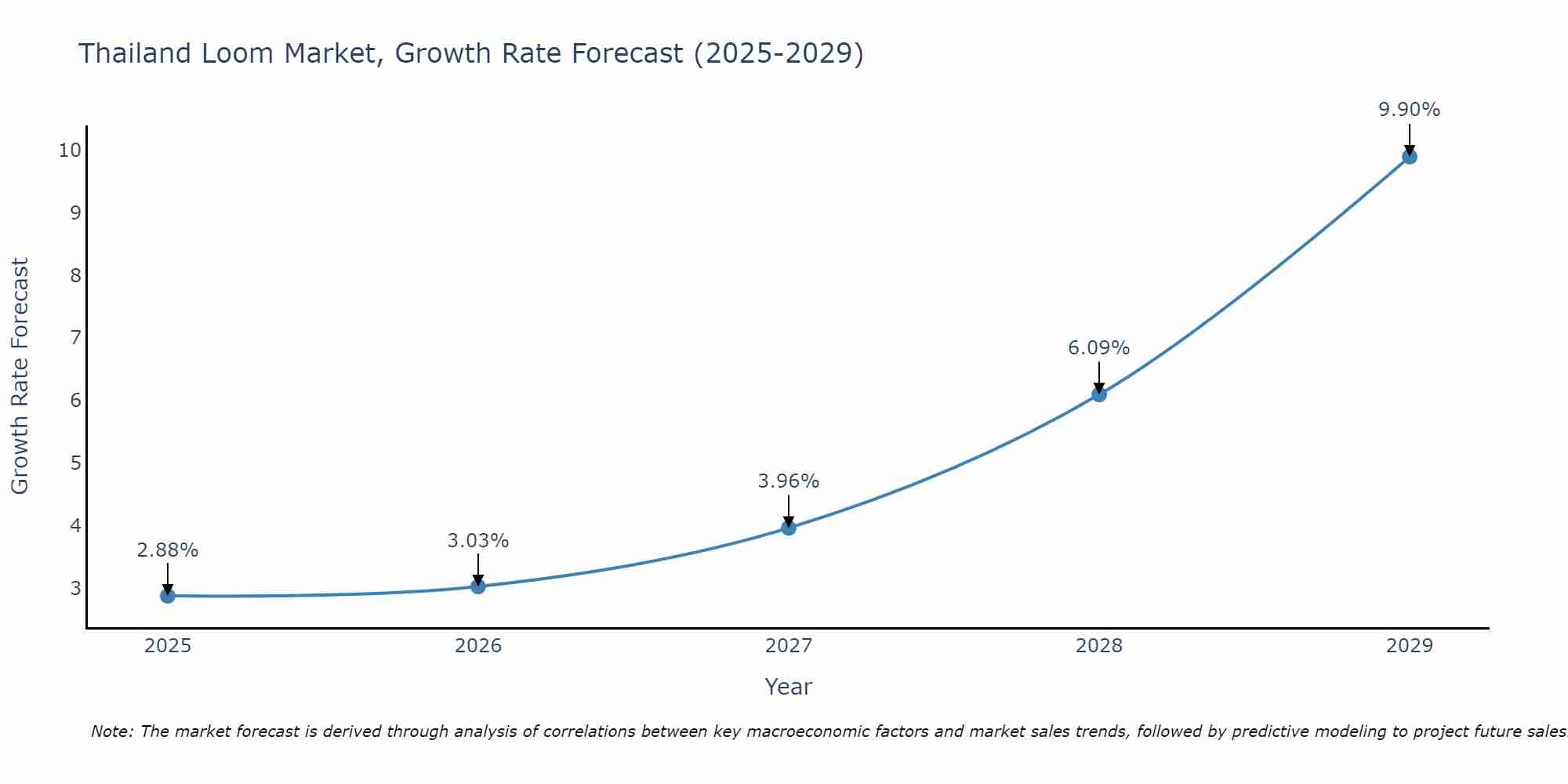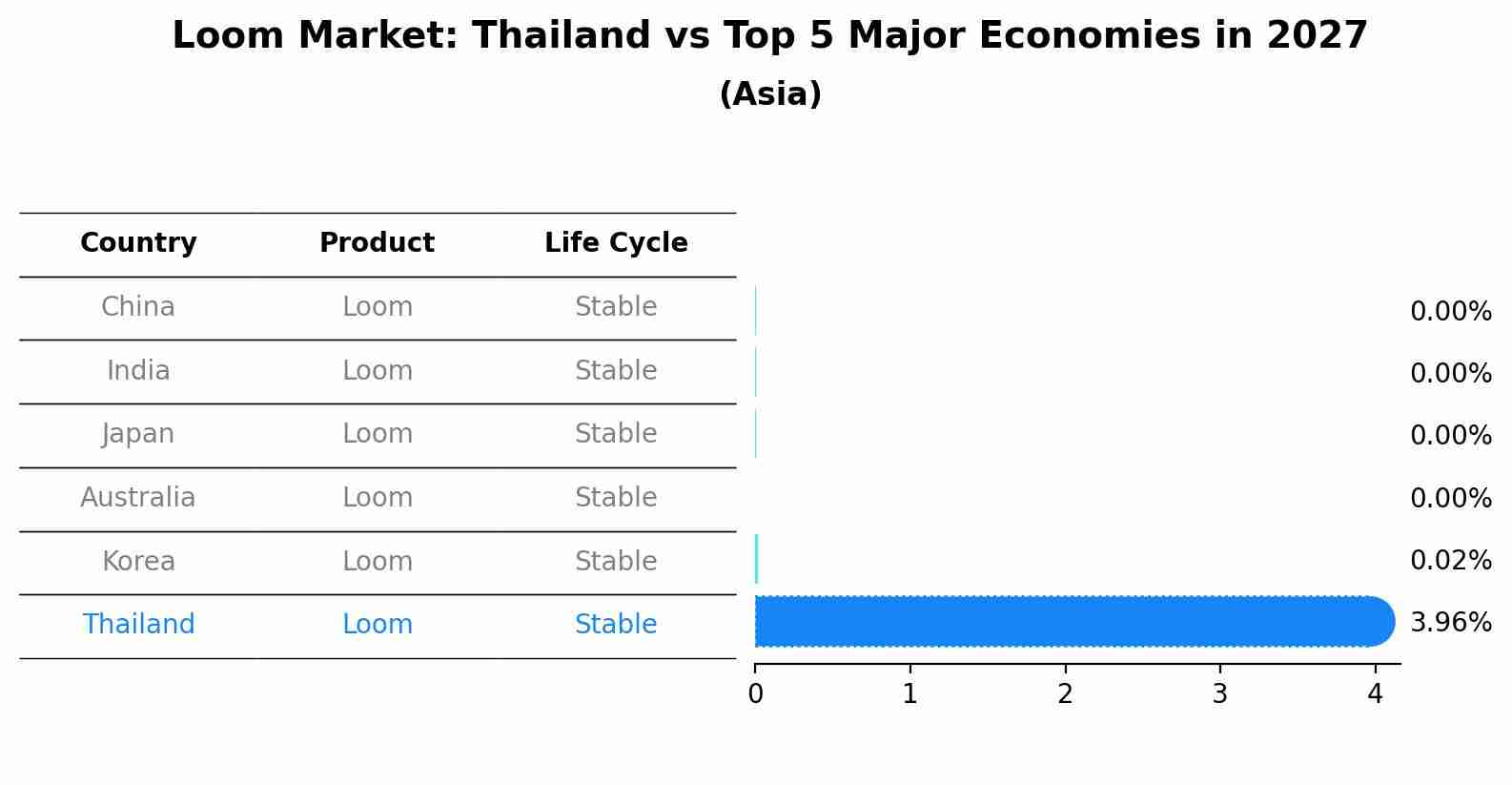Thailand Loom Market (2025-2031) Outlook | Companies, Value, Analysis, Forecast, Growth, Industry, Size, Trends, Share & Revenue
| Product Code: ETC428841 | Publication Date: Oct 2022 | Updated Date: Aug 2025 | Product Type: Market Research Report | |
| Publisher: 6Wresearch | No. of Pages: 75 | No. of Figures: 35 | No. of Tables: 20 | |
Thailand Loom Market Size Growth Rate
The Thailand Loom Market is likely to experience consistent growth rate gains over the period 2025 to 2029. From 2.88% in 2025, the growth rate steadily ascends to 9.90% in 2029.

Loom Market: Thailand vs Top 5 Major Economies in 2027 (Asia)
By 2027, Thailand's Loom market is forecasted to achieve a stable growth rate of 3.96%, with China leading the Asia region, followed by India, Japan, Australia and South Korea.

Thailand Loom Market Synopsis
The Thailand loom market has evolved with the changing landscape of the textile industry. Traditional handloom techniques have gradually given way to mechanized looms that offer higher efficiency and greater output. The textile industry is a significant contributor to Thailand economy, and modern looms have played a pivotal role in meeting the growing demand for textiles domestically and in international markets. The market is characterized by a mix of traditional and advanced weaving technologies, with a focus on producing a wide range of textiles, including silk, cotton, and synthetic fabrics.
Drivers of the Market
The Thailand loom market is propelled by the country`s thriving textile and garment industry. The demand for looms is primarily driven by the need for efficient and advanced machinery to cater to the growing textile production. As Thailand becomes a prominent player in the global textile market, investments in modern loom technologies are on the rise. Furthermore, the government`s focus on promoting the textile and apparel sector through incentives and favorable policies has boosted the adoption of looms.
Challenges of the Market
The Thailand loom market confronts several challenges as well. The traditional textile industry faces competition from cheaper imports, especially from countries with lower labor costs. Modernizing and upgrading loom technology to meet global quality standards is an ongoing challenge for many local manufacturers. Additionally, the skilled labor required for operating these machines is becoming scarcer, necessitating investments in workforce development and training. Environmental sustainability concerns are also emerging, with pressure to adopt eco-friendly practices in textile manufacturing.
COVID-19 Impact on the Market
The Thailand loom market witnessed reduced production and demand during the pandemic, primarily due to disruptions in the textile and garment sectors. With restrictions on international trade, textile exports were affected. However, the market showed signs of recovery as domestic demand for textiles increased in the post-pandemic period.
Key Players in the Market
Leading manufacturers in the Thailand Loom market comprise N.P. Textile Co., Ltd., Sritex Public Co., Ltd., and Phong Phu International Co., Ltd. These companies offer a wide range of loom products and solutions to the textile industry.
Key Highlights of the Report:
- Thailand Loom Market Outlook
- Market Size of Thailand Loom Market, 2024
- Forecast of Thailand Loom Market, 2031
- Historical Data and Forecast of Thailand Loom Revenues & Volume for the Period 2021-2031
- Thailand Loom Market Trend Evolution
- Thailand Loom Market Drivers and Challenges
- Thailand Loom Price Trends
- Thailand Loom Porter's Five Forces
- Thailand Loom Industry Life Cycle
- Historical Data and Forecast of Thailand Loom Market Revenues & Volume By Type for the Period 2021-2031
- Historical Data and Forecast of Thailand Loom Market Revenues & Volume By Hand Loom for the Period 2021-2031
- Historical Data and Forecast of Thailand Loom Market Revenues & Volume By Shuttle Loom for the Period 2021-2031
- Historical Data and Forecast of Thailand Loom Market Revenues & Volume By Modern Loom for the Period 2021-2031
- Historical Data and Forecast of Thailand Loom Market Revenues & Volume By Projectile Loom for the Period 2021-2031
- Historical Data and Forecast of Thailand Loom Market Revenues & Volume By Air Jet Loom for the Period 2021-2031
- Historical Data and Forecast of Thailand Loom Market Revenues & Volume By Multiphase Loom for the Period 2021-2031
- Historical Data and Forecast of Thailand Loom Market Revenues & Volume By Applications for the Period 2021-2031
- Historical Data and Forecast of Thailand Loom Market Revenues & Volume By Home Use for the Period 2021-2031
- Historical Data and Forecast of Thailand Loom Market Revenues & Volume By Commercial Use for the Period 2021-2031
- Thailand Loom Import Export Trade Statistics
- Market Opportunity Assessment By Type
- Market Opportunity Assessment By Applications
- Thailand Loom Top Companies Market Share
- Thailand Loom Competitive Benchmarking By Technical and Operational Parameters
- Thailand Loom Company Profiles
- Thailand Loom Key Strategic Recommendations
Frequently Asked Questions About the Market Study (FAQs):
1 Executive Summary |
2 Introduction |
2.1 Key Highlights of the Report |
2.2 Report Description |
2.3 Market Scope & Segmentation |
2.4 Research Methodology |
2.5 Assumptions |
3 Thailand Loom Market Overview |
3.1 Thailand Country Macro Economic Indicators |
3.2 Thailand Loom Market Revenues & Volume, 2021 & 2031F |
3.3 Thailand Loom Market - Industry Life Cycle |
3.4 Thailand Loom Market - Porter's Five Forces |
3.5 Thailand Loom Market Revenues & Volume Share, By Type, 2021 & 2031F |
3.6 Thailand Loom Market Revenues & Volume Share, By Applications, 2021 & 2031F |
4 Thailand Loom Market Dynamics |
4.1 Impact Analysis |
4.2 Market Drivers |
4.2.1 Increasing demand for traditional Thai textiles |
4.2.2 Growing awareness and appreciation for handwoven products |
4.2.3 Government initiatives promoting local crafts and artisans |
4.3 Market Restraints |
4.3.1 Competition from machine-produced textiles |
4.3.2 Fluctuating raw material prices |
4.3.3 Limited availability of skilled weavers |
5 Thailand Loom Market Trends |
6 Thailand Loom Market, By Types |
6.1 Thailand Loom Market, By Type |
6.1.1 Overview and Analysis |
6.1.2 Thailand Loom Market Revenues & Volume, By Type, 2021-2031F |
6.1.3 Thailand Loom Market Revenues & Volume, By Hand Loom, 2021-2031F |
6.1.4 Thailand Loom Market Revenues & Volume, By Shuttle Loom, 2021-2031F |
6.1.5 Thailand Loom Market Revenues & Volume, By Modern Loom, 2021-2031F |
6.1.6 Thailand Loom Market Revenues & Volume, By Projectile Loom, 2021-2031F |
6.1.7 Thailand Loom Market Revenues & Volume, By Air Jet Loom, 2021-2031F |
6.1.8 Thailand Loom Market Revenues & Volume, By Multiphase Loom, 2021-2031F |
6.2 Thailand Loom Market, By Applications |
6.2.1 Overview and Analysis |
6.2.2 Thailand Loom Market Revenues & Volume, By Home Use, 2021-2031F |
6.2.3 Thailand Loom Market Revenues & Volume, By Commercial Use , 2021-2031F |
7 Thailand Loom Market Import-Export Trade Statistics |
7.1 Thailand Loom Market Export to Major Countries |
7.2 Thailand Loom Market Imports from Major Countries |
8 Thailand Loom Market Key Performance Indicators |
8.1 Number of visitors to traditional textile exhibitions and fairs |
8.2 Percentage increase in government funding for artisanal programs |
8.3 Growth in the number of weaving cooperatives supporting local weavers |
9 Thailand Loom Market - Opportunity Assessment |
9.1 Thailand Loom Market Opportunity Assessment, By Type, 2021 & 2031F |
9.2 Thailand Loom Market Opportunity Assessment, By Applications, 2021 & 2031F |
10 Thailand Loom Market - Competitive Landscape |
10.1 Thailand Loom Market Revenue Share, By Companies, 2024 |
10.2 Thailand Loom Market Competitive Benchmarking, By Operating and Technical Parameters |
11 Company Profiles |
12 Recommendations |
13 Disclaimer |
- Single User License$ 1,995
- Department License$ 2,400
- Site License$ 3,120
- Global License$ 3,795
Search
Related Reports
- ASEAN Bearings Market (2025-2031) | Strategy, Consumer Insights, Analysis, Investment Trends, Opportunities, Growth, Size, Share, Industry, Revenue, Segments, Value, Segmentation, Supply, Forecast, Restraints, Outlook, Competition, Drivers, Trends, Demand, Pricing Analysis, Competitive, Strategic Insights, Companies, Challenges
- Europe Flooring Market (2025-2031) | Outlook, Share, Industry, Trends, Forecast, Companies, Revenue, Size, Analysis, Growth & Value
- Saudi Arabia Manlift Market (2025-2031) | Outlook, Size, Growth, Trends, Companies, Industry, Revenue, Value, Share, Forecast & Analysis
- Uganda Excavator, Crane, and Wheel Loaders Market (2025-2031) | Strategy, Consumer Insights, Analysis, Investment Trends, Opportunities, Growth, Size, Share, Industry, Revenue, Segments, Value, Segmentation, Supply, Forecast, Restraints, Outlook, Competition, Drivers, Trends, Demand, Pricing Analysis, Competitive, Strategic Insights, Companies, Challenges
- Rwanda Excavator, Crane, and Wheel Loaders Market (2025-2031) | Strategy, Consumer Insights, Analysis, Investment Trends, Opportunities, Growth, Size, Share, Industry, Revenue, Segments, Value, Segmentation, Supply, Forecast, Restraints, Outlook, Competition, Drivers, Trends, Demand, Pricing Analysis, Competitive, Strategic Insights, Companies, Challenges
- Kenya Excavator, Crane, and Wheel Loaders Market (2025-2031) | Strategy, Consumer Insights, Analysis, Investment Trends, Opportunities, Growth, Size, Share, Industry, Revenue, Segments, Value, Segmentation, Supply, Forecast, Restraints, Outlook, Competition, Drivers, Trends, Demand, Pricing Analysis, Competitive, Strategic Insights, Companies, Challenges
- Angola Excavator, Crane, and Wheel Loaders Market (2025-2031) | Strategy, Consumer Insights, Analysis, Investment Trends, Opportunities, Growth, Size, Share, Industry, Revenue, Segments, Value, Segmentation, Supply, Forecast, Restraints, Outlook, Competition, Drivers, Trends, Demand, Pricing Analysis, Competitive, Strategic Insights, Companies, Challenges
- Israel Intelligent Transport System Market (2025-2031) | Strategy, Consumer Insights, Analysis, Investment Trends, Opportunities, Growth, Size, Share, Industry, Revenue, Segments, Value, Segmentation, Supply, Forecast, Restraints, Outlook, Competition, Drivers, Trends, Demand, Pricing Analysis, Competitive, Strategic Insights, Companies, Challenges
- Uganda Precast and Aggregate Market (2025-2031) | Strategy, Consumer Insights, Analysis, Investment Trends, Opportunities, Growth, Size, Share, Industry, Revenue, Segments, Value, Segmentation, Supply, Forecast, Restraints, Outlook, Competition, Drivers, Trends, Demand, Pricing Analysis, Competitive, Strategic Insights, Companies, Challenges
- Australia IT Asset Disposal Market (2025-2031) | Strategy, Consumer Insights, Analysis, Investment Trends, Opportunities, Growth, Size, Share, Industry, Revenue, Segments, Value, Segmentation, Supply, Forecast, Restraints, Outlook, Competition, Drivers, Trends, Demand, Pricing Analysis, Competitive, Strategic Insights, Companies, Challenges
Industry Events and Analyst Meet
Our Clients
Whitepaper
- Middle East & Africa Commercial Security Market Click here to view more.
- Middle East & Africa Fire Safety Systems & Equipment Market Click here to view more.
- GCC Drone Market Click here to view more.
- Middle East Lighting Fixture Market Click here to view more.
- GCC Physical & Perimeter Security Market Click here to view more.
6WResearch In News
- Doha a strategic location for EV manufacturing hub: IPA Qatar
- Demand for luxury TVs surging in the GCC, says Samsung
- Empowering Growth: The Thriving Journey of Bangladesh’s Cable Industry
- Demand for luxury TVs surging in the GCC, says Samsung
- Video call with a traditional healer? Once unthinkable, it’s now common in South Africa
- Intelligent Buildings To Smooth GCC’s Path To Net Zero













